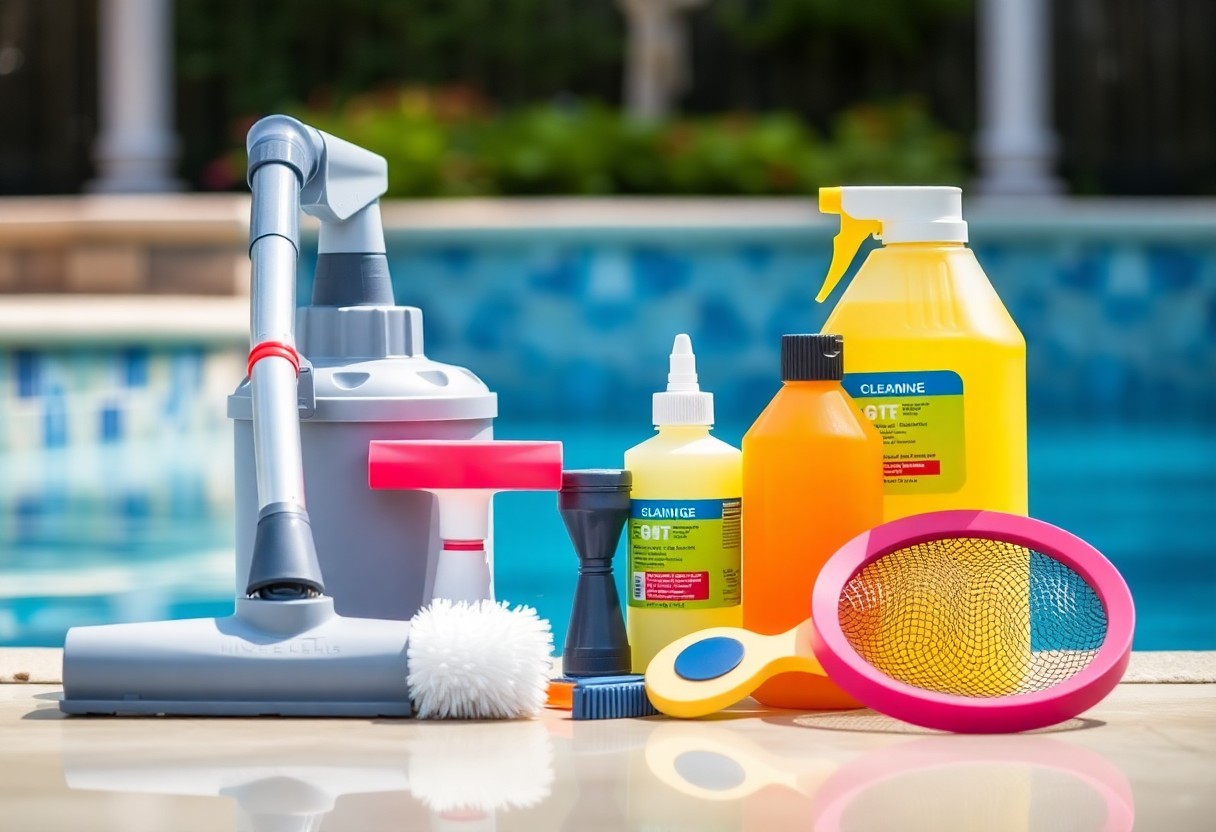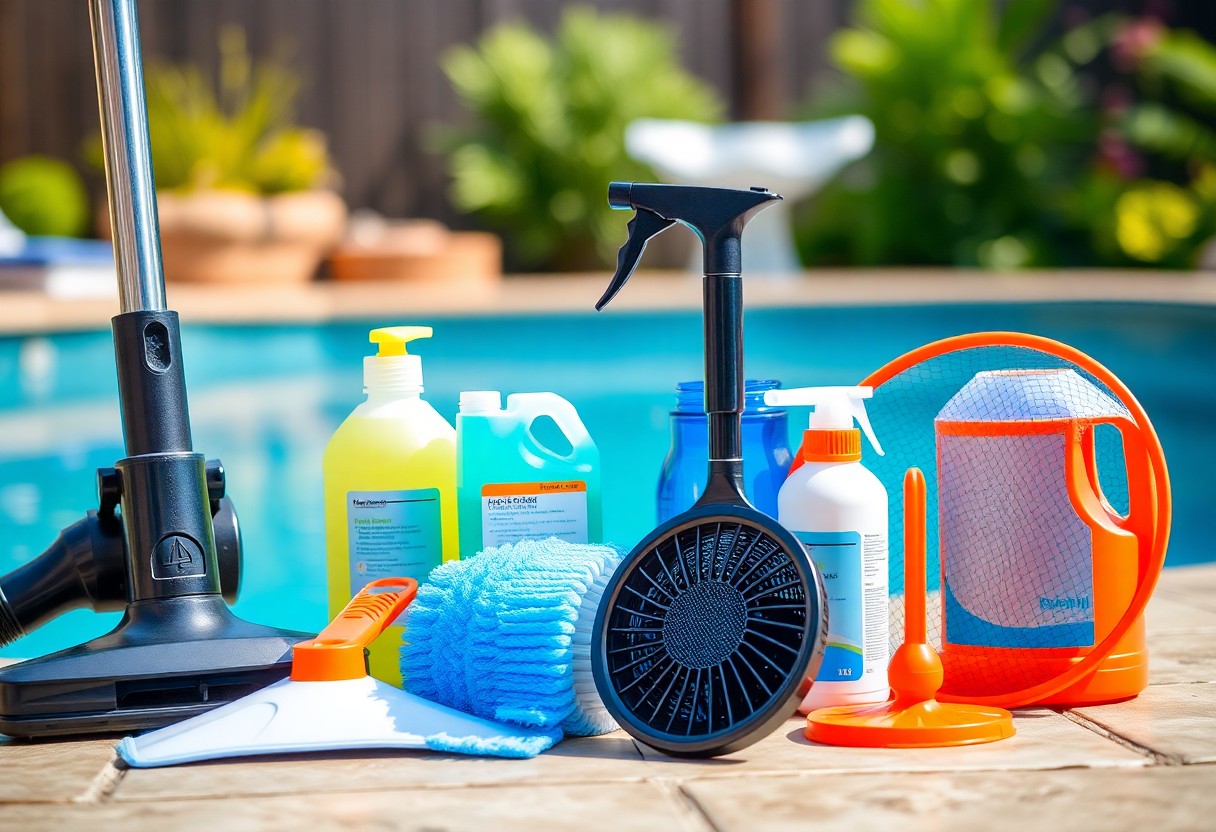Just like any vital part of your pool maintenance, proper cleaning of your pool filter is vital for ensuring its efficiency and longevity. You might think that cleaning your filter is a straightforward task, but many pool owners overlook key details that can lead to costly damage or ineffective filtration. In this post, we’ll guide you through the common mistakes you should avoid when it comes to cleaning your pool filter, helping you maintain a safe and enjoyable swimming environment for you and your family.
Key Takeaways:
- Always follow the manufacturer’s guidelines for cleaning frequency and methods to ensure optimal performance and longevity of the filter.
- Avoid using harsh chemicals or pressure washers, as they can damage the filter media and reduce its effectiveness.
- Make sure to rinse the filter thoroughly after cleaning it to remove any remaining debris and prevent clogging.
Not Following Manufacturer Guidelines
Understanding Filter Types
The effectiveness of your pool filter is significantly affected by how well you understand the different types available. Each filter type, whether it’s a cartridge, sand, or D.E. (diatomaceous earth) filter, has unique characteristics and requires specific maintenance procedures. Below is a breakdown that helps to clarify these types and the routines associated with them.
| Filter Type | Maintenance Needs |
|---|---|
| Cartridge Filter | Clean cartridges with water, replace every 1-3 years. |
| Sand Filter | Backwash every 2-4 weeks, replace sand every 3-5 years. |
| D.E. Filter | Backwash, add D.E. powder regularly, replace grids as needed. |
| Pressure Filter | Clean filter bag when pressure rises, inspect regularly. |
| Inline Filter | Regularly clean or change filters based on manufacturer guidelines. |
Perceiving the differences among filter types can help you maintain your pool more effectively, ensuring a healthy swimming environment.
Reading and Adhering to Instructions
Across every aspect of pool maintenance, adherence to the manufacturer’s guidelines is important. Ignoring these instructions can lead to ineffective cleaning processes and potential damage to your filtration system. Most manufacturers provide detailed instructions specific to your filter type, and neglecting these can result in problems such as clogged filters or reduced efficiency. Ensuring that you are informed about the correct method of cleaning and maintaining your pool filter will help prolong its lifespan and function.
To maximize the lifespan of your filter, it is important that you follow the detailed instructions provided by the manufacturer. This can include recommendations on how often to clean the filter, what cleaning solutions are safe to use, and environmental factors to consider, such as temperature changes that may affect your filter’s performance. Each of these guidelines is designed to protect your investment in your pool’s maintenance system and to keep your water clean and safe for swimming. If you skip steps or misinterpret the details, you increase the risk of potential damage that could necessitate expensive repairs or replacements, leading to significant inconveniences in your pool usage.

Using the Wrong Cleaning Methods
One of the most common mistakes you might make when cleaning your pool filter is using the wrong cleaning methods. It is imperative to know that not all filters are created equal, and the cleaning process can vary significantly based on the type of filter you have—be it sand, cartridge, or diatomaceous earth. Utilizing improper techniques can lead to ineffective cleaning or, worse, can damage your filter, shortening its lifespan. Always consult your manufacturer’s recommendations to ensure you’re using the most appropriate cleaning methods for your specific filter type.
Avoiding Harsh Chemicals
Any time you tackle pool maintenance, the temptation to use harsh chemicals may arise, but this can be a dangerous choice for your filter. Chemicals like bleach or acidic cleaners can corrode vital components of your filter, leading to potential leaks and costly replacements. Opt for milder cleaning solutions that are designed specifically for filters to preserve their integrity and maintain optimal performance. By choosing safer alternatives, you not only protect your equipment but also create a healthier swimming environment.
Proper Backwashing Techniques
Cleaning your pool filter also involves the imperative process of backwashing, but how you do it can make all the difference. Neglecting this task can lead to decreased filtration efficiency, which impacts water clarity and quality. Cleaning your filter efficiently requires you to know the right duration and frequency of backwashing based on your pool’s usage and conditions.
Indeed, understanding the proper backwashing technique is key to maintaining a clean and effective filter. Aim to backwash your filter when the pressure gauge indicates a rise of around 8-10 psi above the normal operating range. The backwashing process involves reversing the flow of water through the filter, which flushes out accumulated debris and contaminants. Ensure that you allow adequate time for the process—typically around 2-3 minutes—while being mindful not to overdo it, as excessive backwashing can waste water and dilute your pool chemicals. By adopting correct backwashing practices, you promote a healthier pool environment and extend the life of your filter system.
Neglecting a Regular Cleaning Schedule
Once again, maintaining a consistent cleaning schedule for your pool filter is key to ensuring optimal performance. If you allow your filter to become clogged or dirty, you risk not only compromising the quality of your pool’s water, but also shortening the lifespan of your equipment. By adhering to a regular maintenance regimen, you can avoid the headache of a major clean-up and keep your pool sparkling clear and enjoyable for you and your family.
Signs Your Filter Needs Cleaning
About recognizing when your pool filter requires cleaning is crucial for effective maintenance. Watch for signs such as a noticeable decrease in water circulation, an increase in the time it takes for the filter to clean the water, or even a visible buildup of dirt and debris on the filter itself. If the pressure gauge on your filter system indicates elevated levels, this is a clear signal that it’s time to address the issue.
Risks of Infrequent Maintenance
Beside the fact that neglecting your filter maintenance can lead to poor water quality, it also exposes your pool to various potential risks. An infrequently cleaned filter can become less efficient, resulting in stagnation, which may promote the growth of harmful bacteria and algae. This makes your pool not only unsafe for swimming but can also result in costly repairs if equipment becomes damaged due to excess strain or malfunction.
But the consequences of ignoring your pool filter maintenance can go beyond just aesthetics and safety concerns. You may also face higher energy costs since your pump will have to work much harder to push water through a clogged filter. Additionally, the investment you made on your pool can quickly become a money pit due to the need for replacements or extensive repairs if proper care isn’t taken. By committing to routine maintenance, you ensure a safer, more efficient, and more enjoyable swimming experience for you and your family.

Reassembling the Filter Incorrectly
Despite your best efforts to clean your pool filter, if you fail to reassemble it correctly, you could end up causing significant issues. The alignment of various components is important to ensure that water flows through the filter as intended. A simple mistake, like switching the positions of two elements or failing to tighten screws fully, can lead to leaks or inefficient filtration. This not only compromises the pool’s cleanliness but may also result in costly repairs or replacements.
Checking O-Rings and Seals
After cleaning and drying your filter components, it’s vital to thoroughly check all O-rings and seals before reassembly. These small but important pieces help keep water from leaking out of the filter and ensure that pressure remains consistent during operation. If you find any cracks, tears, or deformities in the O-rings, consider replacing them immediately. Neglecting this step may lead to water leaks or increased energy consumption, ultimately affecting the efficiency of your pool’s filtration system.
Ensuring Proper Component Placement
Any oversight in the correct placement of filter components can lead to operational problems down the line. Take the time to verify that each piece is returning to its designated spot. This attention to detail is particularly important for multi-part filters, where specific elements may fit together in only one arrangement. If parts are incorrectly placed, you might experience water flow issues or decreased filtration efficiency, which can negatively impact the clarity of your pool water.
Further, always consult your filter’s manual for detailed diagrams and instructions on how to arrange the components correctly. If you’re unsure about any of the steps in reassembling your filter, seeking professional guidance can save you headaches later on. Properly reassembling your filter not only enhances its performance but also extends its lifespan, reducing the chances of needing repairs or replacements too soon.
Overlooking Filter Media Condition
After spending time and effort maintaining your pool, overlooking the condition of your filter media can lead to significant issues down the line. Filter media, whether it be sand, cartridge, or diatomaceous earth (DE), plays a vital role in ensuring your pool water is clean and safe for swimming. If you neglect these components, you may end up facing poor filtration, increased algae growth, and higher chemical costs. To Avoid Pool Cleaning Mistakes with Clean Living Pool & Spa, it’s important to incorporate regular checks on your filter media into your cleaning routine.
When to Replace Sand, Cartridge, or DE
For effective pool maintenance, you should know when it’s time to replace your filter media. Generally, sand filters need to be replaced every 3 to 5 years, while cartridge filters can last around 2 to 5 years depending on usage and maintenance. DE filters require more frequent replacement of the DE powder, but the grids themselves typically last about 5 to 7 years. Regularly checking the manufacturer’s guidelines and assessing your filter media’s performance will help you stay on schedule with replacements.
Effects of Worn-Out Media on Filtration
Along with keeping your pool environment healthy, the condition of your filter media directly impacts the efficiency of your filtration system. Worn-out or damaged filter media can lead to insufficient filtration, which may allow contaminants and debris to circulate back into your pool. This not only affects water clarity and safety but can also strain your pump and other equipment, leading to more costly repairs over time.
To maintain optimal filtration, it’s important to replace any worn-out media as needed. Failing to do so can result in cloudy water, increased chemical use, and a greater likelihood of algae and bacteria growth. You may notice your pool becoming less inviting or even develop skin irritations from swimming in unfiltered water. Prioritizing the condition of your filter media ensures a cleaner, safer swimming experience and prolongs the life of your pool equipment.
Storing and Handling Filters Improperly
All pool owners often overlook the importance of proper storage and handling of pool filters, leading to unnecessary damage and reduced efficiency. When you fail to store your filters correctly, they can be susceptible to elements that compromise their integrity, such as moisture, dust, and pests. So, taking the time to ensure you’re properly storing your pool filters can significantly enhance their lifespan and performance.
Preventing Damage During Storage
For effective storage, ensure that your filters are completely dry before placing them away. Moisture can lead to mold growth, which can permanently damage the filter material. Additionally, avoid stacking heavy items on top of your filters and store them in a climate-controlled area, ideally indoors where temperatures fluctuate less. Using a sealed container will also protect your filters from dirt and other contaminants that could harm their efficiency when you’re ready to use them again.
Correct Handling for Longevity
Preventing damage during the handling process is equally important as proper storage. When you are installing or removing your filters, handle them with care and avoid using excessive force, which can lead to cracks or deformities. Always hold the filter by its structural components and refrain from tugging on hoses or electrical connectors, as these actions can weaken seals and lead to leaks. It’s also advisable to clean filters gently, using non-abrasive materials that won’t scratch or scrape the surface.
Consequently, being cautious and gentle when handling your pool filters will ensure that they remain in optimal working condition for as long as possible. Ensuring that you don’t neglect these steps will keep your filters performing efficiently, minimizing the likelihood of costly replacements and ensuring a cleaner pool experience. By treating your filters with care and attention, you are investing in the longevity of your pool’s overall health.
Final Words
On the whole, avoiding common mistakes when cleaning your pool filter is crucial for maintaining its efficiency and prolonging its lifespan. You should always familiarize yourself with your specific filter type and its cleaning requirements to ensure you’re using the right methods and materials. Neglecting to fully clean the filter, using inappropriate tools, or overlooking manufacturer guidelines can lead to damage or inadequate filtration. Regular maintenance is not just about keeping the water clean; it’s also about preserving the vital components of your pool system.
Hence, staying informed about the best practices for pool filter maintenance is key. You can enhance your pool experience by making a habit of checking your filter’s condition, cleaning it regularly, and being cautious about what chemicals and tools you employ. By sidestepping these common pitfalls, you can enjoy a crystal-clear pool that’s easy to maintain and safe for your family and friends.
